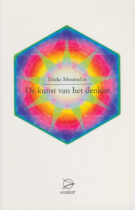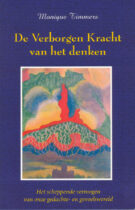De Kunst van het Denken
Door Mieke Mosmuller.
125 Pagina’s | Uitgegeven in 2016 | Softcover | Uitgeverij Occident, Baarle Nassau | ISBN: 978-9075240412.
De intelligentie is voor de meeste mensen een geliefde aanleg, een vaardigheid om trots op te zijn. Op school wordt al vlug gekeken hoe intelligent de kinderen zijn. Er bestaan uiteenlopende tests om de intelligentie kwantitatief vast te leggen (IQ). Ook is de menselijke intelligentie het grote voorbeeld voor de kunstmatige intelligentie. Hoe vernuftig deze laatste intussen in het nabootsen ook is, er is nog lang geen werkelijke mogelijkheid om de levende intelligentie in een technische om te zetten. De meest eenvoudige denkacties van de mens vragen om eindeloze reeksen van besluiten in de techniek – terwijl omgekeerd het apparaat in staat is om in een seconde tot uitkomsten te komen waar een mens in een heel leven niet toe zou kunnen komen . . .
Maar als veld voor spiritualiteit is de intelligentie niet erkend. Het lijkt eerder een gebied dat verlaten moet worden, wil je tot de diepere wijsheden van het bestaan doordringen. In dit boekje wordt een begin gemaakt met het bewijs van het tegendeel. De intelligentie is de geest zelf en door deze bewust in activiteit te brengen – met geen ander doel dan deze activiteit – bewijst de intelligentie zelf haar spiritualiteit. Om dit te kunnen is geen hoog IQ nodig, maar het wordt hierdoor wel vanzelf hoog. Er is geen geloof in wat dan ook nodig – ook dit ontstaat vanzelf. Het enige wat nodig is, is een zekere discipline om twee maal per dag twintig minuten tijd te geven aan de intelligentie.
Afkomstig uit Hoofdstuk: ‘De Spirituele Traditie van het Denken’ (p. 37):
” Dat is de schoonheid van het denken, dat het vrij is van mijn persoonlijke overtuiging. Overtuigingen blijken nog iets anders te zijn dan denken. Overtuigingen kleven aan mijn alledaagse zelf. Het denken maakt mij juist los van mijzelf en tilt me op tot een wereld, die niet subjectief is, maar die ook niet alleen maar objectief is. Het is een absolute wereld, in zichzelf bestaand. Voordat ik begon met dit denken wist ik niet dat zo’n wereld bestaat. Nu begin ik te voelen dat die bestaat en dat ik daarbij hoor, dat ik daar meer bij hoor dan bij de uiterlijke materiële wereld. Ik kan een soort van ’thuis komen’ voelen. “
De Verborgen Kracht van het Denken
By Monique Timmers.
187 Pages | Uitgegeven in 2007, derde druk | Softcover | Uitgeverij Schors, Amsterdam | ISBN: 9789063787035.
Het Scheppende Vermogen van onze Gedachte- en Gevoelswereld.
Wil je meer weten over de Verborgen Kracht van ons scheppend vermogen? Wil je weten hoe gedachtevormen eruit zien, wat hun uitwerking is op jezelf en de ander? Wil je weten hoe je het verouderingsproces kunt vertragen en je geestelijk en lichamelijk welzijn kunt verbeteren? De Verborgen Kracht is het scheppende vermogen van onze denk- en gevoelsprocessen. Het is onze Hogere Denkkracht, gedragen door Universele Liefde. Helaas zijn wij ergens door de levens heen de controle over dit vermogen verloren. We kunnen de natuurlijke controle over de Ware Geest weer activeren en deze kennis terugbrengen in ons dagelijkse bestaan. Laten we deze Goddelijke erfenis aanvaarden!
Afkomstig uit Hoofdstuk 3 – ‘De Wachter op de Drempel: Kies en schep wat je wilt zijn en wie je wilt zijn!’ (p. 45):
” Uit esoterisch onderzoek is gebleken, dat genezing en harmonie het best tot stand komen door eerst alles te accepteren: het ziektebeeld, de eigen verantwoordelijkheid. Dit is niet voor iedereen even gemakkelijk! Kies vervolgens voor het beste en realiseer dit in je denken en handelen. Doe dit met heel je wezen. Vertrouw op je eigen herstelvermogen, weiger iets anders dan liefde te schenken en kies voor gezondheid met heel je wezen! Weet dat ziekte voortkomt uit disharmonische denkpatronen en het feit dat wij ons los hebben gemaakt uit het universele Beginsel. Weet dat zo gauw er disharmonie of onaangenaamheid in onze natuur verschijnt, wij de wet van ons wezen overtreden. Weet dat dit de oorzaak is van elke disharmonie in ons systeem en de oorzaak van ziektes! Disharmonie nemen we levens met ons mee; we conditioneren ons telkens weer! Alles wat een harmonische uitwerking heeft op onze aard en zijnstoestand, dat wat ons gevoelens geeft van harmonie, evenwicht, vrijheid, kracht en liefde, is in overeenstemming met het werkelijke leven en het resultaat kan alleen maar gezondheid en harmonie geven. We kunnen geen disharmonie veroorzaken als we harmonie tot uitdrukking brengen! Harmonie is onze natuurlijke staat van zijn! “
Thought Power – Its Control and Culture
By Annie Besant (1847 – 1933).
122 Pages | 6th edition, 1988. NB: second edition 2016 | Softcover | Quest Books U.S.A. | ISBN: 0835603121.
‘ A brief occult survey of the vast power contained in man’s mental principle. ‘
This brief, easy-to-read study concentrates on the hidden power latent in the human mind, which can do amazing things if properly activated and controlled. An in-depth understanding of this aspect of our nature should bring about a more compassionate metamorphosis of our attitude towards fellow beings, life itself and planet Earth. Western civilization recognizes the immense value of coming to know man as a ‘holisitic entity’, and of coming to terms with man’s mind. The sages of the ancient East and their noteworthy disciple, Annie Besant, have been proven to be most intuitive concerning this unique principle in man.
Subjects discussed are:
- Training the mind
- Improving concentration
- Strengthening thought power
- Meditation
- Improving memory
- Thought transference
- Building the mental body
- Combining thoughts with others
- Achieving peace of mind.
From Chapter VIII – ‘Obstacles to Concentration; Wandering Minds’ (p. 93):
” The concentrated intelligence, the power of withdrawing outside the turmoil, mean immensely increased energy in work, mean steadiness, self-control, serenity; the man of meditation is the man, who wastes no time, scatters no energy, misses no opportunity. Such a man governs the events, because within him is the power whereof events are only the outer expression; he shares the divine life, and therefore shares divine power. ”
Annie Besant (1847-1933) led the fight for the rights of women and laborers in her native England; later she worked with Mahatma Gandhi and spearheaded India’s struggle for freedom. Theosophist Joy Mills describes her as “a feminist before the movement for women’s rights was fully launched; she stood for freedom when half the world was held in the bonds of colonialism.” A student of India’s spiritual traditions, Annie Besant was famed as an orator, author, and international President of the Theosophical Society.
Mindscape – Exploring the Reality of Thought-Forms
By Bruce A. Vance.
197 Pages | A Quest Original, first edition 1990 | Softcover | Quest Books, U.S.A. | ISBN: 0835606600.
‘ . . . a daring and provocative voyage through the nocturnal landscape ‘.
In Mindscape, Vance further charts the still largely unknown fathoms of our mental depths. He shows us that thoughts are real, not just in our heads. They project outward and take on forms in the superphysical field around us. Thoughts have an energy all their own, that can affect others through telepathy. In addition to having a reality beyond our minds, Vance says our thoughts create our world. Beliefs are powerful and tend to ‘come true’. If we believe we are ineffectual or ill, we will be; if we believe we are capable or healthy, we will be.
The author cites experiments in subatomic physics to show how powerful our mindsets are. To further support his views, Vance looks to the work of clairvoyants like Charles Webster Leadbeater (1854 – 1943) and cites cases of shamanistic journeys and out-of-body experiences. By becoming aware of our self-imposed limitations and our greater potential, we can release our mental energies and use them to greater advantage. Vance explains how!
From Chapter 9 – ‘The extended Reach of Mind’ (p. 185):
” So, what are the boundaries of mind? None. What are the boundaries of selfhood? None. And what are the boundaries of consciousness? There are none. The infinity of reality is open to us through exploring our mindscape. But we are physically incarnated for a purpose. There is something important to learn here. It has to do with the powers of creation, some of which are at our disposal. “
Thought Forms
By Annie Besant (1847 – 1933).
77 Pages | First edition 1901, second edition, fourth reprint, 2015 | Hardcover, incl. illustrations | Theosophical Publishing House, Adyar | ISBN: 9788170592020.
Hardly a moment of our waking life passes without thoughts. Are thoughts material? What do they look like? We assume, that being silent and unnoticed by others, ideas and thoughts are insignificant, but each one of them is that much of an unique power, positive or negative for us or others in the measure of its quality and intensity. This is clearly brought out in this publication – first published in 1901 – with the aid of many vivid coloured plates and graphic drawings conveying the power of thought.
 Bezig met bijwerken…
Bezig met bijwerken…



